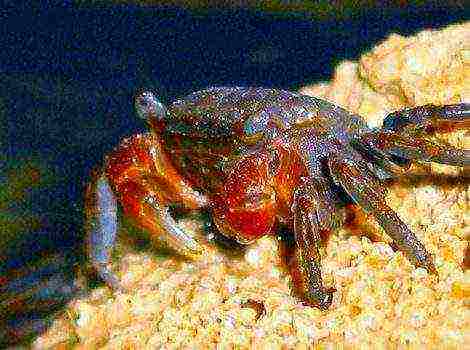Content
- 1 Growing peppers from seeds at home with a step by step photo
- 2 The first shoots have sprung up, what to do next?
- 3 Soil for pepper and top dressing
- 4 Watering
- 5 Growing pepper seedlings on the windowsill
- 6 Additional care
- 7 Interesting
- 8 Useful video
- 9 The choice of container and substrate for seedlings of peppers
- 10 Dive pepper
- 11 Possible problems and solutions
- 12 Landing in open ground
- 13 How to grow
- 14 Pepper seedlings: from seedlings to picking (video)
- 15 Growing hot and sweet peppers in the house
- 16 Growing hot peppers on a windowsill
- 17 How to grow chili peppers at home (video)
- 18 Gallery: pepper at home (15 photos)
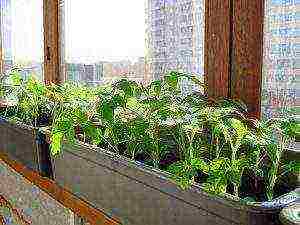
Growing peppers at home is becoming an increasingly popular activity for those who do not have a summer cottage. Now there are many interesting varieties that are suitable for planting on balconies and window sills. If there is not much space in the house, then it is better to choose mini-varieties.
Conditionally, pepper for the home can be divided into sweet varieties and hot ones, there is also a decorative pepper. The latter are more suitable, since they are of short stature and abundant fruiting.
…
However, if you want to grow bell peppers, then there is nothing difficult, you just need to follow the recommendations.
Growing peppers from seeds at home with a step by step photo
This is southern culture loves warmth and bright sunso it is important to provide it with an appropriate location. However, seedlings should be protected from exposure to too bright sun, so as not to burn weak leaves.
Choosing seeds
When you enter a gardening store, you are faced with a difficult choice: which variety is better.
Important! Not all peppers are suitable for balcony cultivation.
Pay attention to the size of the adult plant. You should also take into account the timing of germination and the rate of fruiting. At home, we want to get the fruits as quickly as possible.
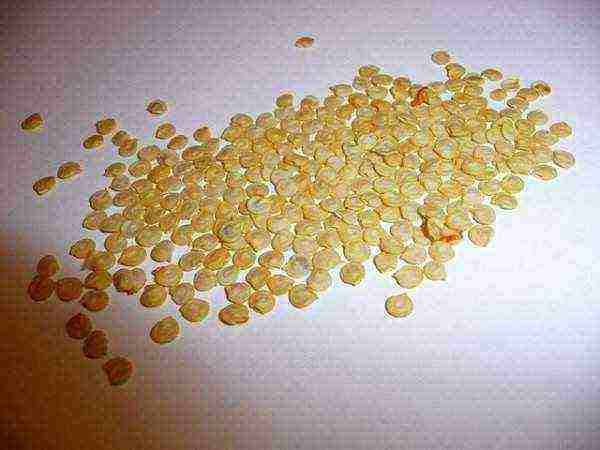
We plant
How to grow peppers from seeds at home? After you have chosen the right variety, you should plant the seeds. Many experienced gardeners recommend pre-soak them in a damp cloth or cheesecloth for four days. There are also recommendations to soak them for several hours in a weak solution of potassium permanganate to avoid the appearance of diseases.
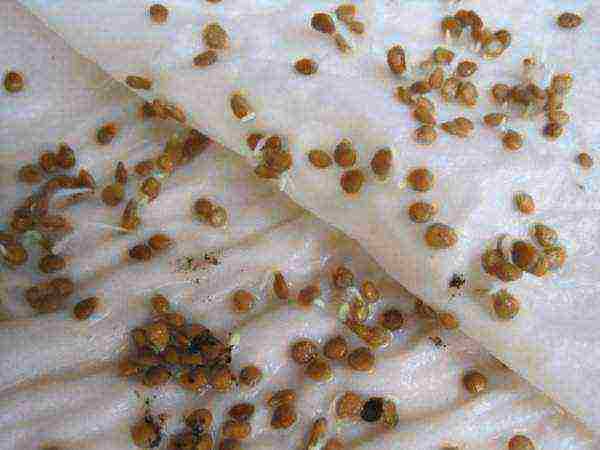
After the seeds have hatched, they must be carefully planted in small containers. For these purposes seedling pots work wellsuch as peat or small plastic cups.
You can plant seeds directly into the ground, they will germinate a little longer. For these purposes also small peat tablets are conveniently suitable for seedlings.
REFERENCE! Learn about planting methods such as toilet paper and snail.
Different varieties germinate in different ways, some up to 3 weeks, so you have to be patient.
Attention! Check soil moisture daily. The soil should not dry out, but also not be too wet. You can use a spray bottle to moisten the soil.
You should adhere to the temperature regime... The optimum temperature for germination of pepper seeds is 18-25ºC.
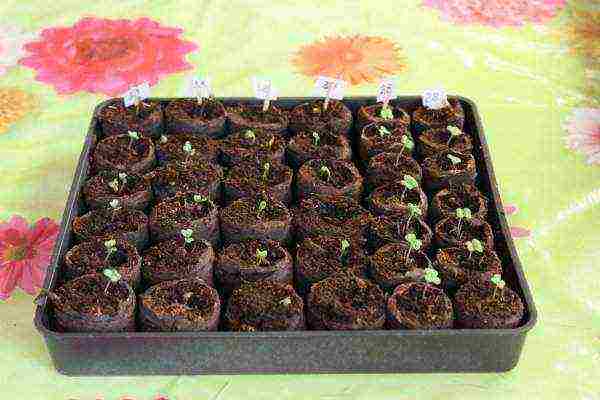
The first shoots have sprung up, what to do next?
After a while, seedlings appear. Now they need create the most optimal conditions... The first is light. If it is not enough, then the plants will begin to stretch, and then completely die.
Attention! Do not place young seedlings directly under the scorching sun.
It is convenient to use artificial lighting for seedlings. Special lamps for flowers are now on sale, but you can also use daylight, choosing the right amount. Incandescent lamps are not suitable for these purposes - they emit little light, but a lot of heat, which can burn delicate leaves.
Daylight lamps are positioned at a height of about 30 cm, daylight hours should last about 18 hours, but not less than 14 hours. In order to make it more convenient, you can connect special on / off control timers to the luminaire.

We land on a permanent place
As soon as the pepper seedlings reach 10-15 cm, it must be dropped off at a permanent place... Use large pots or boxes for these purposes: it grows quickly and has an extensive root system.
We carefully take out the sprout. The most convenient and less traumatic for the plant use the transshipment method... Pepper, sprouted in peat tablets, is planted with them in a pot.
Keep in mind that the larger the planting container, the larger the plant will be. As soon as the frost passes, the plant is taken out to the balcony.
If you grow large varieties of bell peppers, then take care of large containers and methods of garter plants.
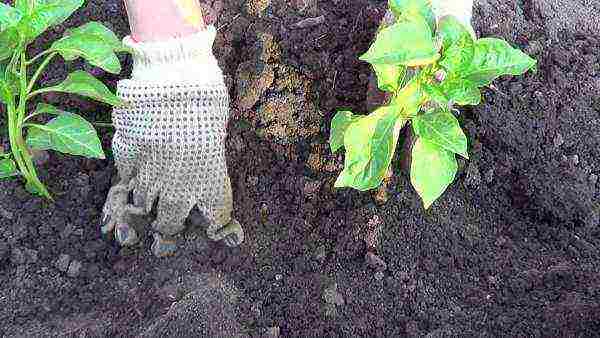
Soil for pepper and top dressing
Fine suitable soil for seedlings, as well as garden soil... Peppers need a lot of nutrients for good fruiting, so humus is added.
Fertilizers are used only specially designed for vegetable crops.
Remember! You eat the fruits, so it is not recommended to over-water with top dressing.
The safest feeding is humus. You can also mix wood ash with water at the rate of 2 tablespoons per liter.
Watering
The plant needs a regular supply of moisture. Water is used warm, better settled, without chlorine... Do not allow the soil to dry out, otherwise the buds and fruits may begin to fall off.
Growing pepper seedlings on the windowsill
As we remember, pepper is a southern culture. Place it in the lightest and warmest place. Avoid drafts. It is great if the balcony is glazed, so you can avoid the effects of spring frosts.
Growing peppers on a windowsill has its own characteristics: choose the lightest window or provide additional lighting.
Additional care
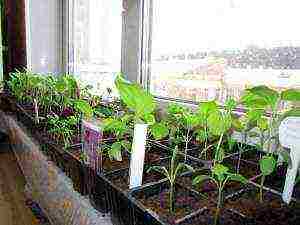 Inspect the plant for pests daily. Even at home in plants sometimes diseases appear and pests attack.
Inspect the plant for pests daily. Even at home in plants sometimes diseases appear and pests attack.
If you notice dark spots, yellow, curled and falling leaves, or insects, take action immediately, otherwise the plant may be lost. What to do if seedlings fall?
Interesting
Many varieties of chili peppers can grow and bear fruit in a room for several years. There is an interesting variety, the fruits of which change color depending on the stage of development. Hot peppers come in varying degrees of pungency. The sizes of the fruits also differ. A small-fruited variety is suitable for the kitchen, it will also be a decoration of the room and an excellent seasoning for dishes.
In general, caring for sweet and hot peppers is not difficult. The most important thing is to germinate the seedlings correctly, choose a large container and ensure the maximum supply of light.
So, today we looked at how to grow pepper seedlings on the windowsill, what nuances do you need to take into account? But growing peppers on the balcony is much easier, so we recommend this method for novice gardeners.
Useful video
Having a fresh, vitamin-rich product in your refrigerator all year round is far from a luxury, but a completely feasible task. It is not only an experienced gardener who can grow pepper seedlings at home. Everyone can cope with this, with a little effort, because, as they say: the eyes are afraid, but the hands are doing!
How to grow pepper seedlings at home
The choice of container and substrate for seedlings of peppers
What you need to know about seedling boxes and pots
Experienced gardeners say that it is best if the container is made of opaque plastic and will not let in the sun's rays. Natural light is useful only for the outer part of the pepper, its leaves, but the roots can be badly damaged by it. The sun's rays slow down the development of the root system, which directly affects the growth rate of seedlings and their quality.
The best container for seedlings is a box made of opaque plastic
There are several requirements for a container for growing pepper seedlings:
- it is desirable that it be integral, not divided into sectors;
- the optimal volume of the container is 0.3-0.5 l (for 2-3 pepper seeds);
- the presence of a flat bottom so that it can be covered with a thin layer of drainage (river pebbles, broken brick, expanded clay, polystyrene).
In order to grow pepper seedlings, wooden boxes, closed on the sides, or peat pots are also ideal. But if nothing like this is at hand, then you can use ordinary disposable plastic containers. And so that the sunlight does not have access to the roots, they can be placed next to each other in a deep cardboard box.
Substrate preparation
As soon as the seedling containers are prepared, it is necessary to proceed with the selection of the substrate. The land, in order for healthy seedlings to grow, must be very fertile. It is better not to use soil from a common garden or vegetable garden, as it has high acidity and is too heavy for pepper.
The soil for pepper seedlings must be very fertile.
The substrate should consist of:
- humus (3 parts);
- turf / peat (3 parts);
- river sand (1 part)
- ash (250 g of ash is added to 5 liters of soil).
If there is no experience in making a substrate, then, in order to avoid risks, you can purchase an earthen mixture in a store. It will contain all the necessary components for the effective and rapid growth of seedlings.
Sowing seeds
Pepper seeds are planted 2-2.5 months before the planned planting in open ground. This is how long it takes for the seedlings to emerge and be ready for transplantation. Usually, seeds are planted in the ground at the very end of winter - early spring. The optimal time is considered to be the end of February - the beginning of March.
The optimal time for planting peppers is late February - early March.
Before planting seeds in a container with earth, they must be properly prepared. The preparation process includes:
- Disinfection. In order for the seedlings to be less susceptible to its characteristic diseases, both the seeds and the container where they will be located must be treated with a weak solution of potassium permanganate (1 g of potassium permanganate per 100 ml of water). The day before planting the seeds, the soil in which they will germinate should also be disinfected: for this, it must be poured abundantly with boiling water, loosened and left to dry until the next day.
Disinfection of seeds with potassium permanganate
- Soak. This procedure is necessary in order to test the seeds for germination. They are soaked for 5-7 minutes in salted water (for 0.5 l of 1 tbsp. L of salt). The planting material that has surfaced can be thrown away without regret - it will not germinate. After the good seeds have been selected for planting, they are soaked again, for 1-2 days to swell.
Soaking different varieties of peppers
- Tank and soil preparation. The bottom is covered with drainage, with a layer of no more than 1.5-2 cm. Soil, previously treated with boiling water, is poured on top. The optimum height of the ground level for planting seeds is 8-10 cm.
Drainage layer with soil for planting pepper seedlings
- Disembarkation... If the container has a rectangular shape, then it can be divided into grooves, about 5 cm wide. The planting material is planted along the grooves at a distance of about 2 cm from each other. From above, the seeds are slightly sprinkled with the same substrate.
Planting pepper with grooves
After the seeds are planted in the ground, they are covered with cling film or glass, and left in a room with a temperature of 23-25 ° C. Over the next few days, it is not necessary to water the planted material, the existing moisture will be enough for it.
Seedling care and feeding
Pepper is a light-loving plant, and even a short-term lack of light can cause irreversible changes in seedlings.
When caring for seedlings, the following conditions must be observed:
1 condition: constant temperature not lower than 20 ° С. In order for the seedlings to grow intensively, the temperature can be increased to 24-26 ° C. The main thing is not to overdo it, because the rapid increase in sprouts can weaken the stem and leaves, they will lack nutrients.
For intensive growth of seedlings, the room temperature should be at least 20 ° С
2 condition: moderate humidity. You need to be careful with watering seedlings: the roots are quickly affected by rot if you overdo it with soil moisture. At the same time, excessive dryness of the substrate can affect further harvest. Pepper watering is carried out:
- after 3-5 days after planting seeds, already in moist soil;
- daily, after the appearance of the first leaves;
- 1 time in 4-5 days, but abundantly, as soon as the seedlings have grown and matured enough.
Watering pepper seedlings is carried out daily, after the appearance of the first leaves
3 condition: feeding. You need to fertilize pepper only a few times from the moment the seeds are planted into the substrate and until the already matured seedlings are planted in open ground. Top dressing is carried out in 2 stages:
- When the first 2-4 leaves appear on the seedlings. The optimal composition of top dressing for 5 liters of water includes 10 g of potassium sulfate, 10 g of urea, 30 g of superphosphate. On average, for every 10 sprouts, 1 liter of the prepared mixture is consumed.
- When more than 5 leaves appear on each sprout. In terms of time, this is about 2-3 weeks after the first feeding. Often, this top dressing coincides with the dive time of the pepper. The procedure must be repeated, increasing the concentration of fertilizers by half. However, to facilitate the work, you can buy ready-made fertilizers and mixtures.
Top dressing of pepper seedlings is carried out when the first 2-4 leaves appear in seedlings
After each top dressing, it is necessary to water the soil with pepper seedlings with plain or melt water to avoid scalding the root system. You should also make sure that neither water nor fertilizer gets on the leaves of the seedlings. They are very sensitive to moisture and minerals.
Video - Tips for growing peppers
Dive pepper
The opinions of gardeners about diving pepper differ: someone advises to carry out this procedure, and someone advises not to touch the seedlings until the very moment of transplanting it into open ground. A dive should be carried out only if the seeds were planted in one whole container. Pepper leaves in the process of growth begin to cast a shadow on each other, which leads to a slowdown in the growth of seedlings or even its death. If, initially, the planting material was seated in separate pots, then this procedure can be neglected.
Preparing the ground for picking pepper
If the planting material was in very fertile soil, which was used to accelerate the germination of seedlings, then the land for picking should be chosen more adapted to the external environment. It is desirable that it be enriched with such macronutrients as potassium, magnesium and phosphorus.
Pepper soil should contain potassium, magnesium and phosphorus.
Pepper pick
Pepper roots are very sensitive to all manipulations. In order not to damage the fragile root system, it is recommended to remove the soil from the container with several shoots at once. The soil is located on a horizontal surface and is carefully separated from the roots of the seedlings.
Shrinkage of pepper seedlings
After the sprouts of the pepper are separated from the substrate, they can be pinched a little, i.e. shorten if they are too long and thin.The shoot is planted in the center of a small container in the ground, the earth around it is compacted a little. The planting field must be watered with pepper.
A. Uncooked root system. B. Root system that has passed the pick
In order for the young sprouts of pepper to feel comfortable and take root in a new place, they need to be protected from bright sunlight for 3-5 days and shortened if they are too long and thin. The shoot is planted in the center of a small container in the ground, the earth around it is compacted a little. The planting field must be watered with pepper.
Possible problems and solutions
It would seem that there is nothing difficult in growing pepper at home. However, some problems may arise on the path of novice gardeners, presented in the table below.
| The seeds did not sprout | Poor quality planting material was chosen; insufficient disinfection of the soil, container and seeds themselves |
Do not store seeds for more than 4 years; carefully carry out the disinfection procedure |
| Seedlings grow very slowly | Lack of light; lack of fertilizer; scarcity of soil; excessive moisture; the effect of light on the roots of seedlings |
Install artificial light lamps aimed at the leaves and stems of the shoots; fertilize and feed seedlings regularly; watering as the land dries up; protect plant roots from light |
| After the dive, the seedlings overgrown and stretched out | Lack of light; planting pepper too early in open ground; excessively favorable indoor climate for growth |
Plant peppers no earlier than mid-April; reduce the room temperature, where the pepper is located, to 18-20 ° С |
Both too favorable and not very favorable, the conditions for keeping pepper seedlings can play a cruel joke with it. If the seedling grows very quickly, its stem becomes very thin and unstable, it can easily break or deform. Therefore, if the growth began to rapidly gain "height and weight", then it should be suspended a little.
Landing in open ground
Growing pepper: from seeds to planting in the ground
Pepper seedlings should be planted in open ground only at a time when the average daily air temperature, even at night, does not drop below 12-14 ° C. A number of conditions must be met:
- Choose a suitable place. Seedlings should be in a sunny, draft-free place.
- Dig up the ground to the depth of the shovel bayonet.
- Fertilize the soil with peat or humus.
- Dig holes for each seedling. The holes should be placed from each other at a distance of 0.3-0.5 m from each other. Rows with seedlings should be at least one and a half meters apart.
- Pour a mineral fertilizer consisting of potassium, phosphorus and nitrogen into each well.
- Carefully remove the seedlings from the pots. It is not necessary to shake off the previous soil from the roots, it is better to plant seedlings in the holes with it. Then it will be easier for the pepper to adapt to changing conditions.
- Place the seedlings in the hole, sprinkle with earth. The layer of dust should be small so that the soil only covers the roots of the plant.
- Water abundantly the planted seedlings in the holes.
- After the moisture has been absorbed into the ground, it is necessary to completely fill the holes so that their surface is equal to the surface of the rest of the soil. The soil with which the pepper will be covered must first be loosened.
- Mulch with peat. Lightly sprinkle the area under the bushes with peat.
If all the rules and conditions are met, and the seedlings successfully take root, then, soon, you will have a fragrant, sweet, environmentally friendly pepper in your beds. With proper care of the plant, it will bear fruit until late autumn.
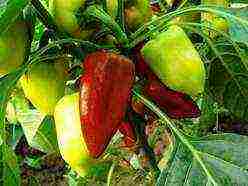 Pepper has long become one of the favorite spices of housewives. Even if there is no way to plant it in the garden, growing pepper at home is a completely simple process. The best place for a vegetable to live would be a windowsill or balcony.And in order to please the harvest, it is worth considering that the plant loves warmth and light, and is also afraid of drafts. Let's take a closer look at the question of how to grow pepper.
Pepper has long become one of the favorite spices of housewives. Even if there is no way to plant it in the garden, growing pepper at home is a completely simple process. The best place for a vegetable to live would be a windowsill or balcony.And in order to please the harvest, it is worth considering that the plant loves warmth and light, and is also afraid of drafts. Let's take a closer look at the question of how to grow pepper.
How to grow
To grow peppers at home, it is worth choosing low varieties, up to half a meter high.Seeds need to be poured with water at room temperature, after adding a little salt there. The specimens that have floated to the surface can be thrown away: they will not bear fruit. The rest should be rinsed with clean water. If the seeds are left in damp gauze overnight, the germination process will go faster.

To grow peppers at home, they need proper care. The room temperature should be at least 15 ° C with high humidity. The plant needs light for 14 hours, therefore, it is better to plant it at home with a long daylight hours or provide it with artificial lighting.
When wondering how to grow pepper seedlings at home correctly and with minimal cost, you need to consider that it is better to buy specially prepared land... It is recommended to connect the soil to the soil taken from the site where it is planned to plant pepper in the future. This is done so that in the future the plant can quickly get used to a new place.
Growing pepper seedlings in your home requires choosing an opaque container, since light affects the roots of the plant worse than the leaves. If there is only a transparent container, then it should be painted with dark paint or wrapped in foil at the bottom to prevent light penetration.

The selected containers must be filled with prepared soil by 7 cm. The day before planting, the soil should be watered abundantly. Pepper seeds are placed shallow, at a distance of no more than 1 cm, and between them it is better to leave a distance of 2-5 cm, depending on the parameters of the container. The planted seeds should be lightly sprinkled with sand and nutrient mixture, and then lightly pressed down with your hand.
Before shoots appear, it is better to cover the container with cellophane. This is done to create a favorable climate that will help the seeds to sprout faster. Until shoots appear, there is no need to water the plant.
When growing pepper seedlings at home, it should be fed a couple of times before planting in open ground... This should be done with special fertilizers. The first time - when 2 or more true leaves appear, the second time - when 5 leaves appear.
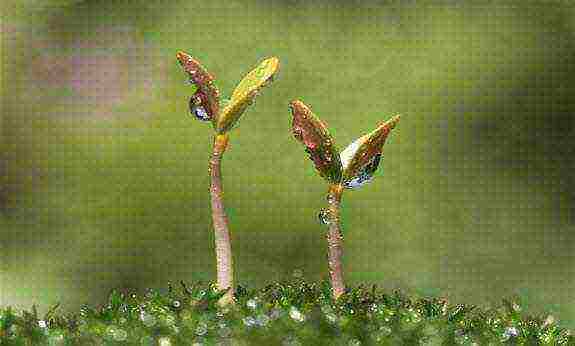
To determine that the cultivation of pepper seedlings is completed successfully and the plant is ready for planting, you can as follows:
- in sweet pepper, the height reached 25 cm and 10 leaves appeared;
- bitter has a height of 20 cm and 5 leaves.
Do not plant bitter and sweet varieties next to it., since the former self-pollinates, and it is highly likely that only this variety will be harvested.
Pepper should be planted in open ground at the end of May, when the soil has already warmed up enough. It does not take root in cold, heavy soil, in this case it is worth adding peat or humus to the soil.
Pepper seedlings: from seedlings to picking (video)
Growing hot and sweet peppers in the house
In principle, there are no big differences between the cultivation of bitter and sweet peppers. The main rules: their habitat should be light and warm.
Many people grow hot peppers on the windowsill. In addition to being a useful, bitter option, it also decorates the interior. You can start growing hot peppers at any time of the year. To do this, you need to take the seeds of the plant, soak them in a weak solution of potassium permanganate, then rinse.
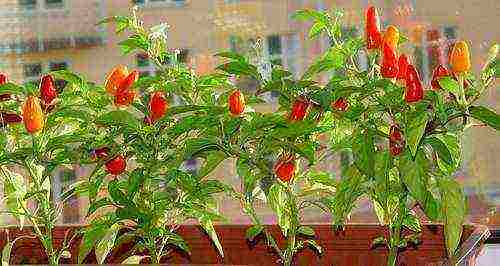
The land for planting must be loose and moist. You should take a small container, pour the soil there, and sow the seeds, about 3. Then you need to sprinkle them a little with earth and water, and then cover with polyethylene until the first shoots appear.
After the indoor pepper has sprouted, it needs to be watered regularly, and once every 7 days it is necessary to feed with mineral fertilizers... When the first crop appears, you can stop feeding.
Growing sweet peppers at home also doesn't require a lot of work. Water it with warm water as needed and fertilize it at least once a month. When the sprouts have 6 leaves, it is better to transplant them into separate pots. And when the plant blooms, it needs to be pollinated, for example, with a soft brush.
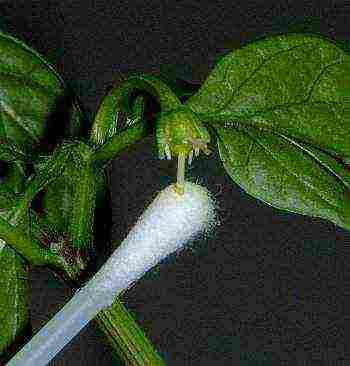
It is worth noting that indoor sweet peppers have a more pronounced taste than those grown in the garden.
Growing hot peppers on a windowsill
In addition to the above types, hot peppers can be grown at home. In cooking, it is used when hot spices are needed, and even improves digestion.
Sowing seeds is recommended in February.
It is recommended to put drainage in the lower part of the container, for this you will need expanded clay. Next, you need to fill in the soil. Before planting pepper in the ground, water it, and then deepen a couple of pre-prepared seeds there. The container should be covered in the same way as described above. When the leaves appear, it is better to transplant the plants into separate containers, so they will be freer. All of the above recommendations are also suitable for growing hot peppers.
How to grow chili peppers at home (video)
Growing peppers at home is a great idea. After all, there will always be fresh peppers on the table, guaranteed without chemicals. And it will also help save money on the family budget, since vegetables are not cheap in the winter season. Good luck!
Gallery: pepper at home (15 photos)
Growing pepper on the balcony and windowsill is an exciting experience. This plant not only brings a vitamin harvest, but also blooms beautifully. It can become a colorful decoration for your home. Black and sweet peppers are perennial plants, so they will bear fruit for more than one year. But the fruits of this culture contain a whole set of substances useful for the body. Read how to grow pepper on a windowsill in the article.
Conditions for Successful Growing of Peppers
You can grow sweet or black peppercorns on the balcony in any container.
We grow seedlings in a small container, and with each transplant we increase the volume of the container.
As a planting container, you can take wooden boxes, plastic pots and buckets, ceramic containers.
The main thing is that there are holes at the bottom of the container for the outflow of excess liquid.
back to content ↑ Lighting
Pepper loves well-lit places in the apartment, so you can grow a good crop on the south or east window. However, direct sunlight negatively affects the life of the plant, so the bushes need to be shaded in hot weather. Lack of light also badly affects black and sweet peppers, so in winter it is necessary to supplement the "pet" with a fluorescent lamp so that daylight hours are at least 10-12 hours.
In the summer season, the pepper feels good on the balcony, but in winter it is necessary to keep the pot on a lighted window in the apartment.
to contents ↑ Temperature
The culture is able to withstand temperatures up to 12-10 degrees, but 24-26 degrees are considered optimal for growth. Both black and bell peppers on the windowsill or balcony should be protected from drafts and sudden temperature jumps.
On the same windowsill at home, you cannot grow sweet bell peppers and bitter, black peppercorns. After pollination, sweet peppers can produce fruit with a bitter taste.
back to contents ↑ Watering
The plant on the balcony or windowsill must be watered with settled water at a comfortable temperature up to 30 degrees. Watering is carried out as the upper layer of the soil mixture dries up. On hot summer days, pepper needs a daily sprinkling. If the container is on the windowsill under the battery in winter, cover it with a damp cloth so that the pepper does not overheat.
Soil and top dressing of pepper
Growing pepper at home on a balcony or windowsill is not difficult, but the choice of soil should be taken seriously. Your best bet is to buy a special dredge from a gardening store. However, you can make soil for planting yourself at home. To do this, you need to mix turf, sand and humus in a 2: 1: 1 ratio. Add lime (150 grams per 10 kg of soil) and ash (1 glass of ash per 5 kg of soil) to the prepared mixture. If you are using regular soil from the garden, then first it should be disinfected with a hot manganese solution.
The culture is fed on the balcony or windowsill once every 14-15 days, but this is done only after watering, so as not to burn the roots.
Fertilizers cannot be sprayed onto the leaves; they are applied only to the soil. Fertilizers can be purchased at the store and must contain enough nitrogen. Top dressing can be done by yourself, for this they take 2 tbsp for 1 liter of water. l. ash. Another option - 1 g is taken for 1 liter of water. urea, 10 gr. superphosphate and 2 gr. potassium salt. Decoctions of herbs (clover, nettle, plantain) will be very useful for pepper. The first feeding is done immediately after the formation of the first true leaves. Black or sweet peppers can be grown without problems in an apartment on a windowsill, but it is better to do this in a seedling way.
back to contents ↑ How to plant peppers for seedlings?
It will not be difficult to grow Bulgarian or black peppercorns at home, but first you will need to plant seedlings. To grow seedlings of sweet or black peppercorns, first you need to start selecting seeds. We remove the damaged seed, and place the selected material in gauze and dip it in a manganese solution or fungicides. We keep the seed in the preparation for about 30 minutes. After that, we wrap the seeds in a wet cloth and moisten it as necessary. We put the seeds in a warm place. After 7-14 days, the seeds should germinate, they must immediately be planted in containers.
Pour the prepared soil mixture into a clean container and crush it a little. We put the sprouted seeds in the ground, retreating from each by 2 centimeters, if the interval is less, then the seedlings will turn out to be elongated. Then sprinkle the seed with a thin layer of soil on top. Then the future seedlings must be very carefully watered with warm water. The pots are placed in a warm place and covered with plastic. Green seedlings should appear in 6-8 days.
Then the seedlings are placed in a lighted area, but the temperature there should not exceed 17-18 degrees. Watering should be very moderate, it is impossible to overmoisten the seedlings. It is best to plant seedlings during the March thaw, so that the plants have enough warmth and light for active development.
to the content ↑ Plant picking
At home, the first leaves are formed 21-30 days after pecking out of the ground. After the appearance of 2 mature leaves, the seedlings dive into another container. It is necessary to transplant seedlings in small separate containers up to 200 ml. In such a container, the seedlings will grow faster, because in a large container, small roots will not be very comfortable. A large pot will accumulate a lot of moisture that the plants cannot process, so there is a risk of rotting.
to the content ↑ Instructions for growing for a good harvest
- We fill the prepared pot with earth mixture and do not forget about drainage.
- We dig a small hole in the soil of such a size that the roots of the sprout are freely located there.
- With gentle movements, we take the seedlings by the tops and transplant them into a new pot. Sprinkle the hole with soil and compact. The root collar should be deepened into the ground by 0.5 cm.
- Holding the sprout, you need to carefully water the soil mixture, the water should be completely absorbed.
- We place the seedlings at home on the windowsill, the lighting should be good, but direct sunlight is contraindicated for plants. Next, we go to standard care, not forgetting to fertilize the pepper.
- When the fruiting period comes, keep 4-5 of the strongest peppers. Others should be removed so as not to overload the plant.
back to content ↑ Pepper varieties
It is best to grow peppers on the balcony - "early ripening" with a low stem. Sweet bell peppers can be of the following varieties:
- Firework;
- Treasure Island;
- Dwarf;
- Golden baby;
- Watercolor;
- Study;
- Karat.
Hot peppers can also feel great on the balcony, and black peppercorns are no exception. The best varieties:
- Falcon's Beak;
- Kolokolchik;
- Bishop's Crown;
- Coral;
- Fiery Virgo.
Black, sweet and other peppers are unpretentious plants, but your care and attention are needed to get the perfect harvest.
Similar articles:

